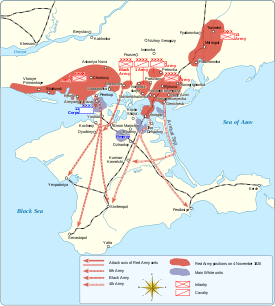Siege of Perekop (1920)
| Donbass-Don Operation | |||||||
|---|---|---|---|---|---|---|---|
| Part of the Southern Front of the Russian Civil War | |||||||
 A map of the Soviet plan for the Perekop–Chongar operation | |||||||
| |||||||
| Belligerents | |||||||
|
|
| ||||||
| Commanders and leaders | |||||||
|
|
| ||||||
| Strength | |||||||
| 41,000 |
186,600 1st Cavalry Army 2nd Cavalry Army 4th Army 6th Army 13th Army Black Army | ||||||
| Casualties and losses | |||||||
| 2,000 | 10,000 | ||||||
The Siege of Perekop was an important battle in the Russian Civil War. It took place from 7 to 17 November 1920.
The operation allowed offensive troops of the Southern Front of the Red Army under the command of Mikhail Frunze to advance against the White Russian army of General Pyotr Nikolayevich Wrangel to break through the fortifications at Perekop and Sivash, leading to the Red Army occupation of the Crimea.
In early 1920, the Crimean Corps under General Yakov Slashchov successfully repelled several attempts of the Red Army to seize the Crimea.
Balance of forces
In November 1920, immediately prior to the main attack on Perekop, the balance of forces was as follows:
- Grouping of forces of the Southern Front, there were: 146,400 bayonets, 40,200 sabers, 985 pieces of artillery, 4435 machine guns, 57 armored cars, 17 armored trains and 45 aircraft.
- Wrangel's Russian Army in the Crimea totaled more than 41,000 soldiers and officers, of which about 6,000 were diverted to fight the guerrillas, security facilities and communications, so in the northern part of the peninsula, there were more than 23,000 bayonets, 12,000 sabers, 213 pieces of artillery, 45 tanks and armored vehicles, 14 armored trains and 42 aircraft.[1]
Fortifications
The construction of fortifications on the isthmus of Perekop began in the autumn of 1919. The White Army defense system consisted of two strips of defense: The Perekop (founded on the Turkish Wall with a total length of 11 km, it included a ditch, barbed wire in 3-5 rows and three lines of trenches) and Ishun (20–25 km from the first line).
There were also fortifications to strengthen the Chonhar Peninsula and the Arabat Spit - up to 5-6 lines of trenches and trenches with barbed wire.
Relatively weak defended was the Lithuanian Peninsula with only one line of trenches and barbed wire.
Approximately 10,000 White Army soldiers defended Perekop and Ishun while 3,000 defended the Syvash, the Chongar Strait and Arabat Spit, a strong reserve. Just over 14,000 were located in the rear.
Planning
Initially, Frunze had planned to deliver the main blow toward Chongar but due to the ice holding back the Azov flotilla, the main attack was transferred on toward Perekop.
The assault on Perekop was executed by the 6th Army, 1st Cavalry Army and 2nd Cavalry Army.
Communists and Komsomol members were sent to strengthen the troops. Just before the operation began, 8,000 Communists and 2,500 Komsomol members were added to the Army.
Fighting
On the night of November 8, 1920, the striking force of the 6th Army, in adverse weather conditions (strong winds and minus 11-12 degrees Celsius), crossed the 7-kilometer water obstacle (Syvash), and captured the Lithuanian Peninsula on that day.
At the same time, the 51st Rifle Division undertook a frontal attack at the Turkish Redoubt. For the purpose of the concentration of forces in the attack, the division was reorganized into six waves - the first component grenade launchers and wire cutters, second - attack aircraft; third - reserve; fourth - "cleaners", and the fifth and sixth - reserve.[2] The attack was not successful.
After back-and-forth fighting, complicated by fluctuating water levels in Syvash bay, the Red Army achieved a breakthrough on November 12, 1920, sending the opposition in general retreat.
General Wrangel had no other option than to evacuate his army from the Crimea to Constantinople.
In popular culture
- Two Comrades Were Serving - 1968 Soviet film, which takes place during the Perekop-Chongar Operation.
- Marshal of the Revolution - 1978 Soviet biopic about the Southern Front commander Mikhail Frunze, covering the events from September 21 to November 16, 1920 (the fighting in the south of the left-bank Ukraine, assault of Perekop and forcing the Sivash, the defeat of Baron Wrangel's army in Crimea).
- The Sun of the Dead - 1923 novel by Ivan Shmelyov focusing on the consequences of the capture of Crimea by the Red Army.
- Sumy Hussars 1651–1951 (Buenos Aires, 1954), a historical overview written by White émigrés, describes the collapse of the 1st Sumy Hussar Regiment's main squadron restored in the Volunteer Army. On 13 November [O.S. 30 October] 1920, the squadron's remnants surrendered to the Bolsheviks near the village of Mamut. A part of the regiment officers committed suicide, others were shot on the spot.